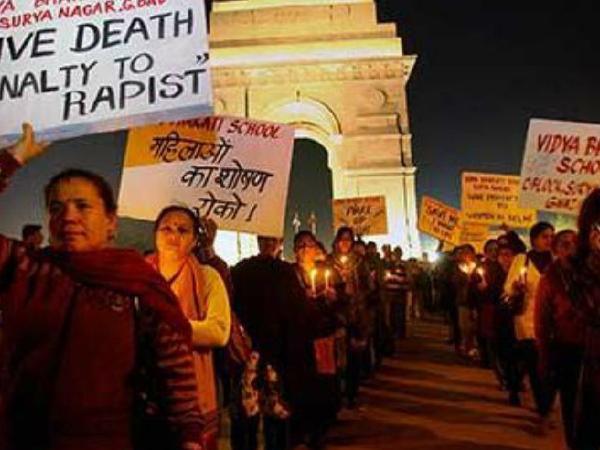I find it appalling that the Union government has expressed its objection to prescribe the noose for child abusers, rapists and paedophiles, for they feel that the death penalty is not an answer for everything.
The law metes out varying levels of punishment for crimes against children. For child harassment, it is imprisonment of up to three years, five years’ imprisonment for sexual assault, and 10 years to life imprisonment for aggravated sexual assault. I strongly feel that they need to change the punishment for a child rapist to the death penalty.
The death penalty is a must
Crimes against infants, children and young girls in particular, are widespread for unfathomable reasons and isn’t it the primary obligation of the law and law-makers to cultivate respect for these victims who are treated with such barbarity and savageness and bring them swift justice? Such heinous crimes are horrific and vile – the perpetrators the lowest form of mankind. A victim of such a crime, not only goes through tremendous mental agony, but also long-lasting fear. There is a need to take extreme steps for stopping this kind of child abuse.
In India, awarding capital punishment is an exception, and not the rule. The Supreme Court has held that only in ‘the rarest of the rare cases’ when the alternative option is unquestionably foreclosed, the court could award a death sentence.
Rape and sexual assault are not merely crimes of passion but an expression of power, and in our social fabric, inter-linkages of caste, religion, poverty, disability and sexual orientation cannot be overlooked. As noted by the Ministry of Women and Children, the crime of child sexual abuse is an under-reported offence in India, which has reached epidemic proportions. For the rape survivor and especially if the survivor is a child, the process of bringing up a complaint in itself can be a traumatising experience. It gets murkier and far more challenging in cases of incest.
Mandatory reporting of the crime of rape is not automatic, and is often dampened by systemic and operational issues. A major systemic issue is that child victims are made to believe that violence is a way of life; it is normal to be abused, and therefore violence meted out against children – especially girls – has to be tacitly accepted or dismissed as inconsequential due to familiarity or relationship status of the abuser.
Other problematic zones are social stigma, safeguarding family honour, threat to life, and adverse repercussions by perpetrators of crime belonging to a dominant caste, economically sound background, and those in positions of power and authority. There is also an administrative indifference and lackadaisical approach in the failure to register the FIR at the time of reporting the incident, insensitivity, ineffectiveness and re-victimisation during various stages of investigation, medical evidence and trial, undue delay and challenges in securing timely judicial redress, and lack of support for victim and witness protection.
Historically, and even today, women and girls are under-represented in the criminal justice system, and over-represented as victims and survivors. Despite positive discrimination and women focussed legislations, implementation is often fraught with misogynistic and stereotypical predisposition about women in general, the offence of rape, and about victims of rape.
Such an uneven landscape calls for overhauling and addressing systemic and operational challenges, by entrenching gender-sensitive and gender-responsive strategies to address widespread violence against women and girls. Awarding death penalty as a punishment for rape can definitely act as a deterrent to any crime. Though we still need to do more.
Making justice child and women-friendly
For ensuring effective implementation of child friendly justice, the state and its machinery must remain committed to end the culture of impunity against the perpetrators by sending out strong and consistent messages of zero tolerance – to crimes of violence against women and girls.
The role and concerted efforts of the first responders – namely the child welfare committees, police and medical officers – is absolutely paramount and crucial in reposing confidence in the child victims and her family. Of equal importance is time bound intervention of the criminal justice system. including public prosecutors and the judiciary.
Serious efforts need to be put into: Revising laws, providing training to police and justice officials on handling such crimes, restructuring services to enable complaints to be handled sensitively and efficiently, and monitoring application of relevant laws and regulations. We also need to identify the points where pressure can be more effective, identify the basis of ‘excuses’ made, and how to use our own culture and values to counter these. We also must identify official commitments already made (e.g., India is a signatory to Convention on the Elimination of all forms of Discrimination Against Women, and to the International Convention on Child Rights – and those international conventions, under international law, are prime over national law); these are tools that can be used in advocacy work.
We need to identify the challenges to be tackled (what, who, where) and adapt the pressure and focus for each ‘actor’ (government service, political leadership, large NGO groups, networks). Then involve all the ‘actors’ in developing strategies and action plans that can lead to a clear national strategy against gender-based violence (and don’t ignore male victims of violence, they’re out there as well, but hidden behind greater taboos) – and national (or state) action plans for implementing this.
Women are still told by society that being a victim of rape is shameful, that seeking justice will only ruin their lives and that raising their voice against a family member will bring dishonour to the family… And unless that thinking changes, capital punishment will make no difference to the reality on the ground.
The other justification for the death penalty is that criminals should get what they deserve, and I truly believe they should. In other words, an eye for an eye, blood in return for blood. Parents and family members of victims have maintained that only a death sentence will satisfy them – and their grief and need for retribution is completely understandable. Capital punishment for a rapist within six months needs to be made mandatory along with the steps mentioned above. We do need to look at the root cause of the issue and address it.
After every incident that captures the nation’s attention, there are calls for stringent measures to deter criminals. There are vociferous debates on TV channels, protests, candle marches and other methods of expressing our collective anguish. Once the anger subsides, the millions of other cases that escape the media’s radar continue to tarnish our national conscience, until another shameful incident comes to light.
Instead of fuelling rhetoric, the media should play a constructive role in ensuring that legislators act with more maturity and objectivity. Our school curriculum should periodically be audited to ensure that they eliminate the scope of perpetuating prejudice, stereotyping and patriarchy.
Rather than making a spectacle of a few perpetrators to score political brownie points, political parties need to deliberate and arrive at a consensus to ensure there is a climate of respect, conducive to gender justice. So long as we don’t honestly introspect and seek solutions, India will remain a regressive society.
Change doesn’t happen overnight, but if people are sufficiently shaken up by some of these extreme examples, it should help mobilise people around action… as long as they’re not allowed to forget until the next atrocity.


 [/column]
[/column]